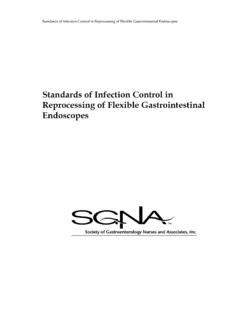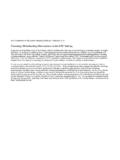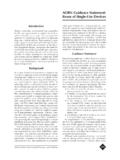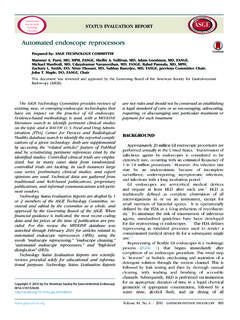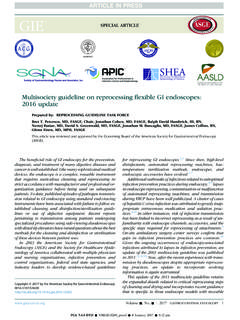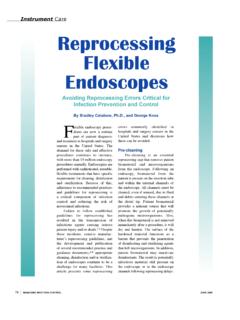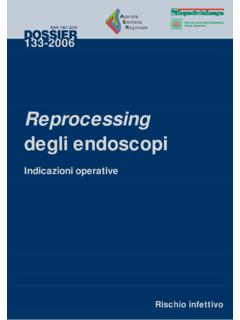Transcription of STANDARDS FOR INFECTION CONTROL AND …
1 STANDARDS of INFECTION Prevention in reprocessing of flexible gastrointestinal endoscopes STANDARDS of INFECTION Prevention in reprocessing flexible gastrointestinal endoscopes society of Gastroenterology Nurses and Associates, Inc. STANDARDS of INFECTION Prevention in reprocessing of flexible gastrointestinal endoscopes Acknowledgements Copyright 2016 society of Gastroenterology Nurses and Associates, Inc. (SGNA). First published in 1996, revised 2000, 2005, 2007, 2008, 2011, 2012, 2015 & 2016. This document was prepared and written by the members of SGNA Practice Committee and adopted by the SGNA Board of Directors in 2016. It is published as a service to SGNA members. SGNA Practice Committee 2015-16. Ann Herrin, BSN RN CGRN, Chair Midolie Loyola MSN RN CGRN, Co-chair Susan Bocian MSN BSN RN. Angela Diskey MSN RN CGRN. Cynthia M. Friis, MEd BSN RN-BC.
2 LeaRae Herron-Rice MSM BSN RN CGRN. Michelle R. Juan, MSN RN CGRN. Marilee Schmelzer, PhD RN. Susan Selking BSN RN CGRN. society of Gastroenterology Nurses and Associates, Inc. 330 North Wabash, Suite 2000. Chicago, Illinois 60611. Tel: (800) 245-SGNA or (312) 321-5165. Fax: (312) 673-6694. Online: Email: Disclaimer The society of Gastroenterology Nurses and Associates, Inc. present this guideline for use in developing institutional policies, procedures, and/or protocols. Information contained in this guideline is based on current published data and current practice at the time of publication. The society of Gastroenterology Nurses and Associates, Inc. assume no responsibility for the practices or recommendations of any member or other practitioner, or for the policies and practices of any practice setting. Nurses and associates function within the limits of state licensure, state nurse practice act, and/or institutional policy.
3 The society of Gastroenterology Nurses and Associates does not endorse or recommend any commercial products, processes, or services. A commercial product, process, or service is recognized as being consumed by or used on patients. society of Gastroenterology Nurses and Associates, Inc. 2. STANDARDS of INFECTION Prevention in reprocessing of flexible gastrointestinal endoscopes Table of Contents Definitions ..5. Introduction ..7. Personnel ..8. Management ..9. Quality reprocessing Environment .11. Spill Containment Plan ..12. reprocessing Accessories ..12. Endoscope reprocessing Protocol ..12. Summary ..26. References ..27. society of Gastroenterology Nurses and Associates, Inc. 3. STANDARDS of INFECTION Prevention in reprocessing of flexible gastrointestinal endoscopes Preface These STANDARDS are presented by the society of Gastroenterology Nurses and Associates, Inc.
4 (SGNA) to be used for all settings where gastrointestinal endoscopy is practiced. They were developed to complement documents developed by the American society for gastrointestinal Endoscopy (ASGE), Association for Professionals in INFECTION CONTROL and Epidemiology (APIC), and SGNA. The current version complements SGNA's Guideline for the Use of High Level Disinfectants and Sterilants for reprocessing of flexible gastrointestinal endoscopes (2013) and the new SGNA Standard of INFECTION Prevention in the Gastroenterology Setting (2015). Proper reprocessing of endoscopes and accessories is critical to the safe and successful treatment of patients. Although endoscopes reprocessed in accordance with manufacturer's reprocessing instructions and INFECTION prevention guidelines pose low risk of transmission of patient-borne or environmental microorganisms, any deviation from the reprocessing protocol can lead to the survival of microorganisms and increased risk of INFECTION (ASGE, 2014; Rutala & Weber, 2015).
5 In the absence of defective equipment, every reported case of hospital acquired INFECTION associated with a contaminated gastrointestinal (GI) endoscope has been linked to a breach or violation of at least one of several requisite reprocessing steps (Koveleva, Peters, van der Mei, & Degener, 2013; Ofstead, Wetzler, Snyder, & Horton, 2010; Petersen et al., 2011). Drug-resistant INFECTION outbreaks have recently occurred and have been traced to endoscopes that were reprocessed following strict adherence to reprocessing procedures (FDA, August 4, 2015). The outbreaks were specifically related to duodenoscopes used for endoscopic retrograde cholangiopancreatography (ERCP). The elevator channel was found to be particularly difficult to clean and required additional cleaning steps. In response to the problems with duodenoscope reprocessing , the Food and Drug Administration (FDA) provided a list of supplemental duodenoscope reprocessing measures (2015), and the CDC released an official health advisory alerting health care facilities to review their reprocessing procedures (September 11, 2015).
6 The FDA listed supplemental measures to consider when reprocessing duodenoscopes, including microbiological culturing, ethylene oxide sterilization, use of a liquid chemical sterilant, and repeated high-level disinfection (August 4, 2015). They recommended that health care facilities performing ERCP evaluate whether they have the resources necessary to perform these options but did not mandate any changes at the time this document was published. SGNA recognizes that some facilities may choose ethylene oxide sterilization and provides a general FAQ sheet on Gas Sterilization of endoscopes (SGNA, April, 2015). While this document ( STANDARDS of INFECTION CONTROL in reprocessing of flexible gastrointestinal endoscopes ). does not address gas sterilization, it is important to note that sterilization cannot be effective unless the device has first been meticulously cleaned and high-level disinfected (Rutala &.)
7 Weber, 2013; CDC, 2015). society of Gastroenterology Nurses and Associates, Inc. STANDARDS of INFECTION Prevention in reprocessing of flexible gastrointestinal endoscopes The focus of this standard is to highlight the expectations of reprocessing staff and management responsibilities, the reprocessing environment, the steps in reprocessing and rationale for their use, and quality assurance. Definitions For the purpose of this document, SGNA adopted the following definitions: Anionic detergent refers to a type of surfactant (see surfactant definition below). Automated endoscope reprocessor (AER) refers to machines designed for the purpose of cleaning and disinfecting endoscopes and accessories. Bioburden refers to the microbiological load ( , number of viable organisms in or on an object or a surface) or organic material on a surface or object prior to decontamination, or sterilization.
8 Also known as "bioload" or "microbial load" (Rutala et al., 2008). Biofilm refers to a matrix of different types of bacteria and extracellular material that can tightly adhere to the interior surfaces of endoscopes (Roberts, 2013). Cleaning refers to removal of all soil and organic material. Cleaning must precede disinfection or sterilization. Competency refers to an expected level of performance that integrates knowledge, skills, abilities, and judgment (American Nurses Association [ANA], 2013). Detergent refers to a surfactant or mixture of surfactants used for cleaning. Endoscope refers to a tubular instrument used to examine the interior of the hollow viscera. In this document, endoscope refers only to flexible gastrointestinal endoscopes . Enzymatic detergent refers to low-foaming detergents which add enzymes such as proteases, amylases, and lipases that are capable of digesting organic material such as blood and mucous.
9 High-level disinfectant refers to a chemical germicide that has been cleared by the FDA as capable of destroying all viruses, vegetative bacteria, fungi, mycobacterium and some, but not all, bacterial spores, within the labeled exposure time and temperature (Rutala et al., 2008; Miner, 2013). High-level disinfection (HLD) refers to the destruction of all microorganisms with the exception of low levels of bacterial spores (Rutala, 2013). society of Gastroenterology Nurses and Associates, Inc. STANDARDS of INFECTION Prevention in reprocessing of flexible gastrointestinal endoscopes Material Safety Data Sheet (MSDS) refers to a descriptive sheet that accompanies a chemical or chemical mixture and provides information regarding the identity of the material; physical hazards, such as flammability; and acute and chronic health hazards associated with contact with or exposure to the compound.
10 Minimum effective concentration (MEC) refers to the lowest concentration of active ingredient necessary to meet the label claim of a reusable high-level disinfectant/sterilant (AAMI, 2015; Food and Drug Administration (FDA), 2015;. Rutala et al., 2008). Personal Protective Equipment (PPE) refers to specialized clothing or equipment worn by an employee for protection against a hazard (ASGE, 2008; FDA, 2015;. OSHA, 2012). reprocessing refers to the validated process of cleaning then disinfecting, or sterilizing endoscopes and accessories. In relation to endoscopy, it includes all the steps from pre-cleaning to drying. Residual organic soil refers to substances such as blood, carbohydrates, or proteins that are left on the scope after manual cleaning (Alfa, 2013). Reuse life refers to a statement by the manufacturer indicating the maximum number of days a reusable high-level disinfectant/sterilant might be effective (AAMI, 2010).
